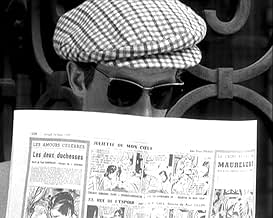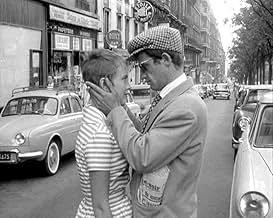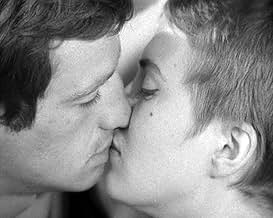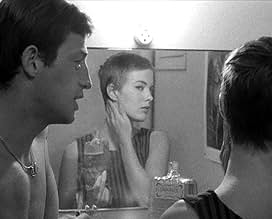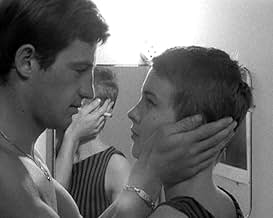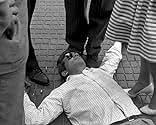Um pequeno ladrão rouba um carro e mata impulsivamente um policial. Procurado pelas autoridades, ele conhece um estudante de jornalismo e tenta convencê-la a fugir com ele para a Itália.Um pequeno ladrão rouba um carro e mata impulsivamente um policial. Procurado pelas autoridades, ele conhece um estudante de jornalismo e tenta convencê-la a fugir com ele para a Itália.Um pequeno ladrão rouba um carro e mata impulsivamente um policial. Procurado pelas autoridades, ele conhece um estudante de jornalismo e tenta convencê-la a fugir com ele para a Itália.
- Direção
- Roteiristas
- Artistas
- Indicado para 1 prêmio BAFTA
- 5 vitórias e 4 indicações no total
Jean-Paul Belmondo
- Michel Poiccard a.k.a. Laszlo Kovacs
- (não creditado)
Jean Seberg
- Patricia Franchini
- (não creditado)
Richard Balducci
- Tolmatchoff
- (não creditado)
Daniel Boulanger
- Police Inspector Vital
- (não creditado)
Gérard Brach
- Photographer
- (não creditado)
Philippe de Broca
- A Journalist
- (não creditado)
José Bénazéraf
- Man in a White Car
- (não creditado)
Jean Domarchi
- A Drunk
- (não creditado)
Jean Douchet
- A Journalist
- (não creditado)
Liliane Dreyfus
- Liliane
- (não creditado)
- …
Michel Fabre
- Police Inspector #2
- (não creditado)
Jean-Luc Godard
- The Snitch
- (não creditado)
Roger Hanin
- Carl Zubart
- (não creditado)
Henri-Jacques Huet
- Antonio Berrutti
- (não creditado)
Raymond Huntley
- A Journalist
- (não creditado)
André S. Labarthe
- Journalist at Orly
- (não creditado)
- Direção
- Roteiristas
- Elenco e equipe completos
- Produção, bilheteria e muito mais no IMDbPro
Avaliações em destaque
10IZMatt
I don't blame those who state that they do not "understand" the superlatives surrounding Jean-Luc Godard's 1960 masterpiece, Breathless. It's primarily because to appreciate Breathless, one has to view the movie from a historical context, which also requires studying of not only the French New Wave, but film theories as a whole, and the lives of those apart of the New Wave. Breathless accomplished many things unprecedented prior (many completely unprecedented, but some things are not-so-much).
Roger Ebert put it best when he said that just as film fanatics may now stand outside a movie theatre waiting for the next Quentin Tarantino movie to be released, film enthusiasts were doing so for Godard in the 1960s. He was a revolutionary, which is why MovieMaker magazine called him the 4th most influential director of ALL-TIME (only behind Welles, Griffith, and Hitchcock)! What did Godard do different? Breathless is all style, simple as that. The story line is interesting, yes, but is Godard's aesthetics, production modes, subject matters, and storytelling methods that are key. First of all, the whole movie was shot on a hand-held camera, just like most all New Wave pictures. It was, however, only shot by two people (Godard and his cinematographer, Rouald) on a budget that did not top $50,000, a mere fraction of what most pictures cost at the time (another facet of the New Wave). It was shot completely on location in Paris, and utilized new film-making techniques that would be used by film-making students for decades to come (such as putting the camera in a mail cart on the Champs Elysees and following Belmondo and Seberg). Note Godard's use of American cinema influence, and how the montage art of the 1950s impacted this aesthetic.
(A brief New Wave lesson: Most New Wave directors were displeased with the "tradition of quality," or the older generation directors who, as Truffaut put it, made the "twelve or so" pictures per year that represented France at Venice and Cannes. Most of these pictures classic or modern literary adaptations, completely stagnant in artistic quality with rehashed subject matters based on historical periods. New Wave directors supported NEW tales of modern Parisian life, primarily, and were sick of the themes found in the tradition of quality films.) The storytelling methods in Breathless are perhaps the most fascinating part of the film. The jump cuts may seem lame, but one must again view them from a historical context: it had never been done before. This is exactly why Breathless is important -- practically every technique was revolutionary. They are so submerged into film-making practices now that Breathless seems typical. Yet at the time, it was, as I said prior, unprecedented.
Roger Ebert put it best when he said that just as film fanatics may now stand outside a movie theatre waiting for the next Quentin Tarantino movie to be released, film enthusiasts were doing so for Godard in the 1960s. He was a revolutionary, which is why MovieMaker magazine called him the 4th most influential director of ALL-TIME (only behind Welles, Griffith, and Hitchcock)! What did Godard do different? Breathless is all style, simple as that. The story line is interesting, yes, but is Godard's aesthetics, production modes, subject matters, and storytelling methods that are key. First of all, the whole movie was shot on a hand-held camera, just like most all New Wave pictures. It was, however, only shot by two people (Godard and his cinematographer, Rouald) on a budget that did not top $50,000, a mere fraction of what most pictures cost at the time (another facet of the New Wave). It was shot completely on location in Paris, and utilized new film-making techniques that would be used by film-making students for decades to come (such as putting the camera in a mail cart on the Champs Elysees and following Belmondo and Seberg). Note Godard's use of American cinema influence, and how the montage art of the 1950s impacted this aesthetic.
(A brief New Wave lesson: Most New Wave directors were displeased with the "tradition of quality," or the older generation directors who, as Truffaut put it, made the "twelve or so" pictures per year that represented France at Venice and Cannes. Most of these pictures classic or modern literary adaptations, completely stagnant in artistic quality with rehashed subject matters based on historical periods. New Wave directors supported NEW tales of modern Parisian life, primarily, and were sick of the themes found in the tradition of quality films.) The storytelling methods in Breathless are perhaps the most fascinating part of the film. The jump cuts may seem lame, but one must again view them from a historical context: it had never been done before. This is exactly why Breathless is important -- practically every technique was revolutionary. They are so submerged into film-making practices now that Breathless seems typical. Yet at the time, it was, as I said prior, unprecedented.
Jean-Luc Godard intended to shake the delicate world of cinema, that much is obvious. But did he intend to reinvent it? Whether it was his intention or not isn't the point, the point is this; he did. Jean-Luc Godard, and Francois Truffuat are the undisputed fathers of the French New Wave. Some cinephiles or historians may feel like pointing elsewhere, to Jean Renoir for example, protesting that he is truly the father of the French New Wave, I disagree entirely. The French New Wave was a product of the kindred spirits and talents of Godard and Truffaut. And no other film represents the French New Wave more coherently than Jean-Luc Godard's dazzling 1960 picture, 'Breathless'. Unorthodox and uninhibited. Raw and experimental. Godard broke every rule in the book, disavowed the laws of cinema, and scribed a new rule book, one where the pages are blank, and possibilities are endless. The story is so simple I can summarize the entire film in half of a sentence, but I refuse to give you or Godard the satisfaction. What counts in Breathless is not the story, but how the story is told. The very definition of 'cool', the film is robust in creativity, and exuberant in its flaws, and passionate about its reckless behavior. Self aware and rebellious. If there was no breathless, there would have been no Tarantino, if there was no French New Wave, the streak of genius that ran through the nineties and 2000s wouldn't have existed. Before Breathless, it was believed that films took money, that you had to find yourself in a place of authority to make a film. Breathless broke this misconception. Breathless makes you want to run outside and make the film of your life. Breathless made that possible, Breathless made the amateur the auteur, Breathless reinvented the face of the cinema, and made you believe that could too. All you need is a girl and gun.
I finally did it. I finished watching À bout de souffle. I kept putting it off because I usually have problem when everybody tells me that such and such film is the epitome of its era or it breaks all the rules, starts the revolution, and reinvents the cinema. That's why, probably, I cannot like Citizen Kane - try to watch the arguably best film ever made - you will be under a lot of pressure.
Well, À bout de souffle does not put you under the pressure, it takes you for a ride, and you follow for 90 minutes its incredibly young characters, common crook (Jean-Paul Belmondo) and his American free-spirited girlfriend (Jean Seberg) on their journey on the streets of 1960-th Paris along with Raoul Coutard's legendary camera. I am not going to tell here how great the camera work was, how fantastic the music score and the views of Paris were - the fans of the film know that already. They also know about the beginning of French New Wave, and how it influenced the future cinema. I just want to say that the movie was made over forty years ago - the smoking was cool back then, and Belmondo made smoking look very sexy. Belmondo fascinates me in this film. I've seen him in a lot of later movies - he's always been good (I recommend Le Magnifique, 1973 and Le Professionnel,1981 ) - but in À bout de souffle he is not just good - he is embodiment of cool, his face changes its expression every moment, you can not take your eyes off him. Is it me or he does remind the very young Mick Jagger - not commonly handsome but irresistible and sexy? He and young (she was 21 at the time) Jean Seaborg made one of the best screen couples ever. My favorite scenes:
Michel drives the stolen car in the beginning of the film, and he starts to talk to us, the audience. The day is nice, the sun is shining, and the life is beautiful...
Michel and Patricia drive in the convertible. The wind plays with her short hair. We only see the back of her head and her neck. Michel tells her that he loves the girl with a beautiful neck, wrists, knees, but she is a chicken...
Patricia comes to the hotel to find Michel in her bed. They start talking about nothing and about very serious things. They smoke, she tries to find a good place for her new poster, and he wants to sleep with her. In the end of the scene, his face, he looks at her - there is love in that look...
There is more - I am sure everyone who saw it has his/her favorite scenes.
Well, À bout de souffle does not put you under the pressure, it takes you for a ride, and you follow for 90 minutes its incredibly young characters, common crook (Jean-Paul Belmondo) and his American free-spirited girlfriend (Jean Seberg) on their journey on the streets of 1960-th Paris along with Raoul Coutard's legendary camera. I am not going to tell here how great the camera work was, how fantastic the music score and the views of Paris were - the fans of the film know that already. They also know about the beginning of French New Wave, and how it influenced the future cinema. I just want to say that the movie was made over forty years ago - the smoking was cool back then, and Belmondo made smoking look very sexy. Belmondo fascinates me in this film. I've seen him in a lot of later movies - he's always been good (I recommend Le Magnifique, 1973 and Le Professionnel,1981 ) - but in À bout de souffle he is not just good - he is embodiment of cool, his face changes its expression every moment, you can not take your eyes off him. Is it me or he does remind the very young Mick Jagger - not commonly handsome but irresistible and sexy? He and young (she was 21 at the time) Jean Seaborg made one of the best screen couples ever. My favorite scenes:
Michel drives the stolen car in the beginning of the film, and he starts to talk to us, the audience. The day is nice, the sun is shining, and the life is beautiful...
Michel and Patricia drive in the convertible. The wind plays with her short hair. We only see the back of her head and her neck. Michel tells her that he loves the girl with a beautiful neck, wrists, knees, but she is a chicken...
Patricia comes to the hotel to find Michel in her bed. They start talking about nothing and about very serious things. They smoke, she tries to find a good place for her new poster, and he wants to sleep with her. In the end of the scene, his face, he looks at her - there is love in that look...
There is more - I am sure everyone who saw it has his/her favorite scenes.
So says the novelist in response to Patricia's question, "What do you hope to attain out of life?" That response is the philosophy of the film and of every character in the film. All want to be in control of their destiny. All want to be something that they are not. None are able to do any of these things. They are all contradictions. How can you die as an immortal? How can Patricia be free and independent is so many other things determine what she can do? How can this film transcend the screen while existing on the screen? This is an amazing film to watch. Goddard fills every scene with ingenuity and energy. He puts his actors in a beautiful environment and lets them do their thing. And they do it extremely well. The actors are beautiful. Not just cosmetically, but spiritually and psychologically. I am not sure that I liked either of the two main characters. I am sure I could not keep my eyes off them. I could not take my eyes off the screen. Techniques that novices today use for no substantial purpose are utilized by Goddard to amazing effect. The greatest filmmakers are the great editors. Goddard makes the editing a character itself. It is the nervous narrator hurrying the film along. It breathlessly awaits the next scene, and leads us to do the same. I like the way Goddard spends prodigious time simply watching his characters. The conversation scene at the center of the film is amazingly long and drawn out, yet I did not find it boring. I found it fascinating. People are fascinating. Everyone is trying to be something. It takes tremendous talent to indulge in the minutiae of existence. A great film.
"À Bout de Soufflé" aka "Breathless", was the first full-length film directed by the controversial Jean-Luc Godard, and the first film of his long career that I've had the chance to see so far. "Breathless" is the landmark film of the Nouvelle Vague (New Wave), when young filmmakers such as François Truffaut thrilled the audiences and shocked the Establishment.
Although some people may not be as impressed with "Breathless" structure as they were in 1960, it remains a terrific, breathtaking film experience and has aged wonderfully. Such masterpieces live up to the hype and time, even though they're not as technically impressive as they were 40 years ago, and they're still powerful thanks to what great films consist of: passion. As another user rightfully stated, we have to look at "Breathless" from a historical point: it's different from any other previous film. Godard was truly a visionary and an incredibly talented, passionate "auteur".
"Breathless" plot is rather simple: Michel Poiccard/Laszlo Kovacs (Jean-Paul Belmondo), our anti-hero, is a young criminal on the run from the police, after stealing a car and killing a cop. He has an affair with a beautiful young American, Patricia (Jean Seberg), an aspiring journalist who sells the New York Herald Tribune in the middle of the Champs Élysées (her first scene here was paid a tribute by Eva Green in Bertolucci's "The Dreamers"), and is also expecting Michel's baby. Patricia helps Michel to dodge the police, while they steal cars together in order to raise money for a trip to Rome. But when you want to "vivre dangereusement jusqu'au bout" - or, live dangerously till the end, things may end up not so well.
When you see Belmondo touching his lips, trying to imitate Humphrey Bogart's trade mark, Seberg walking on the Élysées as lovely as a girl can be, the unforgettable final moments...you don't worry about theories on why this is a classic. "À Bout de Soufflé" is Cinema.
Although some people may not be as impressed with "Breathless" structure as they were in 1960, it remains a terrific, breathtaking film experience and has aged wonderfully. Such masterpieces live up to the hype and time, even though they're not as technically impressive as they were 40 years ago, and they're still powerful thanks to what great films consist of: passion. As another user rightfully stated, we have to look at "Breathless" from a historical point: it's different from any other previous film. Godard was truly a visionary and an incredibly talented, passionate "auteur".
"Breathless" plot is rather simple: Michel Poiccard/Laszlo Kovacs (Jean-Paul Belmondo), our anti-hero, is a young criminal on the run from the police, after stealing a car and killing a cop. He has an affair with a beautiful young American, Patricia (Jean Seberg), an aspiring journalist who sells the New York Herald Tribune in the middle of the Champs Élysées (her first scene here was paid a tribute by Eva Green in Bertolucci's "The Dreamers"), and is also expecting Michel's baby. Patricia helps Michel to dodge the police, while they steal cars together in order to raise money for a trip to Rome. But when you want to "vivre dangereusement jusqu'au bout" - or, live dangerously till the end, things may end up not so well.
When you see Belmondo touching his lips, trying to imitate Humphrey Bogart's trade mark, Seberg walking on the Élysées as lovely as a girl can be, the unforgettable final moments...you don't worry about theories on why this is a classic. "À Bout de Soufflé" is Cinema.
Você sabia?
- CuriosidadesDespite reports to the contrary, Jean-Luc Godard did not shoot the film without a script; however, he did not have a finished script at the beginning, instead writing scenes in the morning and filming them that day. See also O Demônio das Onze Horas (1965).
- Erros de gravaçãoDuring street shots, countless passersby look at Patricia and Michel and stare into the camera, revealing that the shots were made without filming barriers and simply used street pedestrians in place of extras.
- Citações
Patricia Franchini: What is your greatest ambition in life?
Parvulesco: To become immortal... and then die.
- ConexõesEdited into Pariz pripada nama! (2016)
Principais escolhas
Faça login para avaliar e ver a lista de recomendações personalizadas
Detalhes
- Data de lançamento
- País de origem
- Idiomas
- Também conhecido como
- Sin aliento
- Locações de filme
- 11 rue Campagne Première, Paris 14, Paris, França(on location)
- Empresas de produção
- Consulte mais créditos da empresa na IMDbPro
Bilheteria
- Orçamento
- FRF 400.000 (estimativa)
- Faturamento bruto nos EUA e Canadá
- US$ 414.173
- Fim de semana de estreia nos EUA e Canadá
- US$ 32.424
- 30 de mai. de 2010
- Faturamento bruto mundial
- US$ 594.039
- Tempo de duração1 hora 30 minutos
- Cor
- Mixagem de som
- Proporção
- 1.37 : 1
Contribua para esta página
Sugerir uma alteração ou adicionar conteúdo ausente






